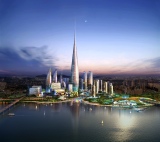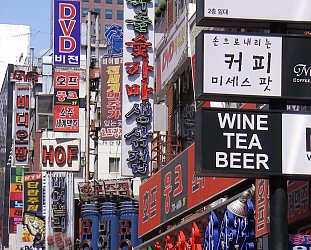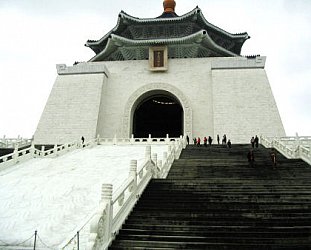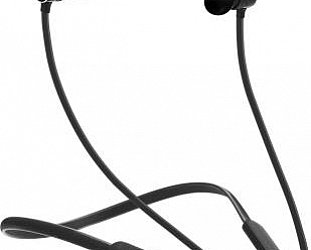Graham Reid | | 11 min read

If we are blunt but honest, Seoul -- the capital of South Korea -- can be a hard-edged place where commerce is ruthless and street-life sometimes bruising. That doesn’t mean there isn’t anything to see in this 600-year old city, in fact quite the opposite.
The sentry outside Deoksugung Palace gate in downtown Seoul looks like he is standing guard outside the Dunkin’ Donut behind him.
That is an odd, but typical, juxtaposition in Seoul because here is a city where the modern sits alongside the traditional: outside a gallery of cutting-edge digital art the local vegetable salesman in a battered truck with a megaphone is announcing his daily specials.
In hot-wired Seoul -- where there is 91.8 percent internet penetration into homes and people of all ages are comfortable with emerging technologies -- the old and the new are in fascinatingly close proximity. And the architecture can be thrilling, whether it be a multi-coloured temple or a steel’n’glass slice of Modernism like the breathtaking Nuritkum Tower in the district known by an appealingly futuristic name, Digital Media City.
With a population of 10 million Seoul is a vibrant, attractive and very different Asian city. It is well worth a visit.
But you had better go now because soon another Seoul will have arisen along the banks of the Hangang (the Han River), one that will redefine concepts of commercial architecture and urban living and, the Koreans hope, make their city the business and tourism hub of Northeast Asia.
Seoul will become “a new Manhattan of the East” I was told on a recent trip, although I also heard it described as “the centre of the future, the centre of the world”, “the global creative city” and “the new soul of Asia”. A man in horn-rimmed glasses assured me, “we will realise these goals”.
There are plans -- and bulldozers ready -- to transform this hard-edged, bristlingly busy city known for its commerce and creativity into what, on extensive architectural and civic design plans, looks like Dubai with trees. “Hard city to soft city” is one of the many slogans employed to encapsulate this ambitious makeover.
Elegant buildings will pierce the skyline, there will be new parks with restful walkways, and museums, art galleries and high-tech malls will be incorporated into a civic makeover that is breathtaking in its daring and impressive in its integrated urban planning.
Digital walls and designer outlets, an opera house, arts centres and urban housing, digital rivers snaking invisibly between the high-tech high rise apartment and business towers . . .
Seoul intends to position itself as the hub of Northeast Asia and is openly challenging Beijing, Shanghai and Hong Kong.
Around Seoul’s perimeter there will be four new industrial belts as satellite developments, and the Hangang Renaissance alone -- an over-arching project to reinvigorate the river and its banks into a recreational area with jet skis, water traffic, new parks and cultural spaces -- involves 33 separate projects. It is as bold as it is visionary -- but that is only the half of it: in the Yongsan Business District which has been the old commercial gateway to Seoul since 1700 a whole new city will arise with the name Dreamhub.
And this urban remake is all going to happen within the next 12 years.
In the time it takes to get planning permission in Auckland, Seoul will have torn down large tracts of the central city and thrown up signature skyscrapers which look like they have leapt from Philippe Starck’s drawing board.
Sceptics will understandably dismiss the timeframe for such a major urban project -- 3.3 million square metres in the centre of an already bustling city will be redeveloped -- but recent Korean history supports their self-belief.
Seoul was a charred ruin just 55 years ago when the city had been a battleground in the Korean War. As a matter of pride after the end of that war -- and the Japanese Colonial Period which had preceded it -- South Koreans rebuilt their capital and embraced modernity. Within a couple of decades towering housing blocks -- now in their hundreds -- encircled and penetrated the city centre (many admittedly a blight on the current landscape) and a city which had been broken and was broke rose, quite literally, from ashes.
Koreans are also the hardest working people on the planet (laws enforcing a 40-hour week were recently enacted to slow them down), and when given slogans and a vision -- and the Dreamhub project provides those in abundance -- they get a job done.
South Korea has the seventh fastest economic growth rate in the world and a young, design-aware citizenry -- average age 36.7 years -- attuned to the rhetoric of progress.
“The 21st century,” says one promotional DVD for the redevelopment, “has gone beyond selling functions to selling sensitivity. Even when buying a mobile phone the consumer takes design into consideration. This is the same for cities.”
And Seoul’s civic designers are looking to Paris, London, Barcelona and Sydney whose urban culture and iconic buildings have pulled in commerce and tourism dollars.
Development is rapid in Seoul because of a streamlined system of local government which Aucklanders can only envy. First, it should be noted that aside from a few Japanese Colonial Period buildings and the palaces, not a lot of current architecture in Seoul is worth protecting. Most was built for function rather than form, so few citizens will weep for the faceless office blocks and low-rent housing demolished to realise the new vision.
And despite its size and geographical spread Seoul has only one mayor (three vice-mayors) and he argues good civic design will draw tourists -- 12 million annually by 2020 -- and business.
Mayor Oh Se-hoon -- young, good looking, charismatic and persuasive -- is a former lawyer and congressman who backs the digital revolution, convincingly delivers inspirational slogans such as “design is air” and wants his city to be the lifestyle capital of the East.
He is supported by powerful alliances and Dreamhub is being fast-tracked through the involvement of public and private sector consortiums: 29.9% public, the balance in subsets of major conglomerates such as Samsung, Lotte, Hyundai and the like.
These companies -- chaebols as they are known -- are hydra-headed organisations with their grip on various aspects of Korean and international commerce: Samsung for example is the world’s second largest conglomerate with electronics, shipbuilding, engineering and construction in its portfolio.
When these companies want things done they have the clout and contacts to do so -- and they want this $130 billion Dreamhub project done.
The district around Yongsan Station has been redesignated for development and the US military base currently in the zone will be moved.
So, some specifics about Dreamhub: there will be a computerised intelligent-parking system to deal with 33,000 vehicles daily; all buildings, commercial or domestic, will have the latest digital technologies and be scrupulously eco-friendly; and 700,000 transit users will pass through central Yongsan Station daily.
There will be twin 100-storey landmark office towers designed by Marshall Strabala (who was involved in the design of Canary Wharf in London and the Burj Dubai in the UAE, among other landmark projects), as well as 10 luxurious 60-storey residential towers.
There will be pedestrian malls and an open space to challenge New York’s Central Park, a multi-media square with a central glass structure for the staging of exhibitions, balls and fashion shows (connected to the underground retail area), and a “super club“ of spas, restaurants and bars, sports facilities and pools.
There is also attention to small detail too: city signage will be standardised using a new font created for the purpose, and there will be colour-coding of specific areas.
And while scepticism may be understandably high over such a massive urban makeover one thing needs to be noted: it has already begun.
Five years ago Seoul started an ambitious urban-renewal project under the city’s then-mayor (now Korean president) Lee Myung-bak. The ancient, dry Cheonggye Stream which ran through what is now central Seoul had long been covered by urban development and an elevated highway.
But a $1.1 billion project was mooted to move the road, uncover the historic river and have water flow through it again. Cheonggye Stream was to become a centrepiece for the city where local people and tourists could amble along pathways on its banks. There was one proviso however: the whole project -- which uncovered unexpected artefacts on excavation -- would be undertaken without any disruption to the city’s traffic or local retailers. And there were 170,000 cars a day along the highway and Cheonggye Street.
That this seemingly impossible project was completed within two years is a testament to what can happen at the nexus of will, a work-ethic and truckloads of money.
Yes, there were subsequent bribery charges and the stream is more manufactured than natural (the water has to be pumped through it) -- but the six kilometre walkway is undeniably pleasant, has lead to ancillary development, and at one end there is an impressive spiral sculpture by Claes Oldenburg.
Today Cheonggye Stream is the focus for festivals, a destination for tourists and locals -- as was intended -- and an example to Koreans and the world of what is achievable in this city.
There has also been major redevelopment of the banks of the Hangang to allow greater pedestrian access to the waters and parks which have been cut off by wide swathes of motorways (which are being put underground), and that will be an on-going project rather immodestly called “the Hangang Renaissance”.
It too is part of the massive redesign of riverside Seoul which includes waterfront towers, marinas, an international passenger shipping terminal and water-taxis to compliment the many bridges (which will be dramatically illuminated).
If the Cheonggye Stream project was the model for what was possible then the new mayor Oh Se-hoon has been quick to follow in the footsteps of his predecessor.
Last year his city was unanimously awarded the World Design Capital 2010 by the jury of International Council of Societies of Industrial Design, an award which has given focus and impetus to the redevelopment projects.
Marc Newson, award-winning designer and WDC 2010 jury member noted “Seoul’s economic figures and its position as the centre of South Korea’s rapid development speaks for Seoul’s enhanced global status as design city.”
In his acceptance speech Seoul’s mayor Oh observed, “design is a growth driver of the Seoul economy . . . with Seoul’s designation as WDC 2010, the city will be able to breath creative energy into the design industry and reinvent itself into a globally recognised city of design, and collaborate with other cities in the world to communicate with design. Seoul will send out the message that design is the power to change the world for the better.”
Jury member Patricia Urquiola, in praising Seoul‘s rapid progress, also observed that, “it is telling that the W Hotel chose Seoul as its first location outside of North America.”
The dramatic, hard-wired W Hotel-Walkerhill on Mt Acha to the east of the city and overlooking the Hangang is emblematic of just how cutting-edge Seoul can be. Among its architectural teams were designers from Studio Gaia in New York and RAD (Hong Kong), and New York-based Tony Chi.
In the chic lobby are long and low seating areas -- and egg-shaped loungers -- and the elegant WooBar with a DJ booth in a spaceship-like sphere. Throughout the hotel are digital artworks activated by light sensitive cameras which means they are constantly changing, and the lifts are funky. One has hand holders hanging from the ceiling as in subway carriages. The 252 guest rooms come with CD players, a DVD library and high speed internet access as standard features. The interiors are sumptuous and the exterior is a bright polka-dot pattern.
The W Hotel-Walkerhill could be in Manhattan or high-end Tokyo -- and that is what Seoul is aiming for in the next decade.
Already off the drawing board is the remake of 80-year old Dongdaemun Stadium, once a 30,000 seat athletics arena but in recent years a flea market. The Seoul Metropolitan Government invited eight internationally acclaimed architects to submit proposals for developing this central city site and its surrounding areas, and in August last year announced the winner: Baghdad-born Zaha Hadid who in 2004 won the Pritzker Prize, often described as the Nobel for architects.
Hadid’s design for the $324 million makeover -- due for completion in 2010 -- is breathtaking: long sweeps of grassed areas and walkways which snake upward over a landscaped park and shopping plaza.
Dongdaemun in the north east is some way from the Dreamhub business district but, as with the satellite industrial parks and Digital Media City to the west of downtown, these developments will be integrated over the next decade.
The Digital Media City is symbolic of the vision of the Seoul Metropolitan Government: it was mooted in the mid 90s as a centre for creative IT and media industries, and today provides high-tech office space and 7000 plugged-in, environmentally-friendly residential apartments. Less than 20 minutes from central Seoul by subway or road, and just 30 minutes from the international airport at Incheon, DMC is a stand-alone centre of digital creativity. It is also a pointer to an on-line future that Korea is also embracing: e-government.
Mayor Oh sees on-line participation in civic matters as the future of a democracy which is quick, reactive, efficient and environmentally friendly. There is, of course, a slogan for this too: “u-Seoul” which means “ubiquitous Seoul” and the word has been adopted widely to encapsulate the idea of universal, integrated technologies from phones linked to civic services, to handheld computers tied in to domestic appliances.
In Seoul it can seem that plans, slogans and catchphrases are a commonplace. But so is progress, the penetration of digital technology and the will to make the city the new hub of Northeast Asia.
Can it happen?
If there is an economic downturn then certainly plans will be affected, but my travels in Asia after “the economic bubble burst” -- a phrase Japanese businessmen chanted like a depressing mantra after 1997 -- tells me that once a project in Asia achieves critical mass and momentum it won’t easily be stopped. And the vision in Seoul has already started rolling. So have the bulldozers.
Of course anything can happen in the world of Korean politics as the once popular but currently beleaguered president could affirm. But Mayor Oh is ambitious and political success in Seoul is a stepping stone. Two previous mayors of Seoul went on to become presidents.
Seoul already boasts striking urban design in its wine bars, restaurants, art galleries, nightclubs and commercial buildings. It is all part of a new design ethic emerging in this vibrant and exciting city.
So? Billions of dollars, wide swathes of land cleared and developed, digital infrastructure, parks and open spaces, happy people, a clean and green future . . .
Yes, I know what you are thinking: will there be flying cars too?
Even so, my money is still with that man in horn rims who said “we will realise these goals”.
This article first appeared in Idealog issue 17. Sept/October 2008












post a comment